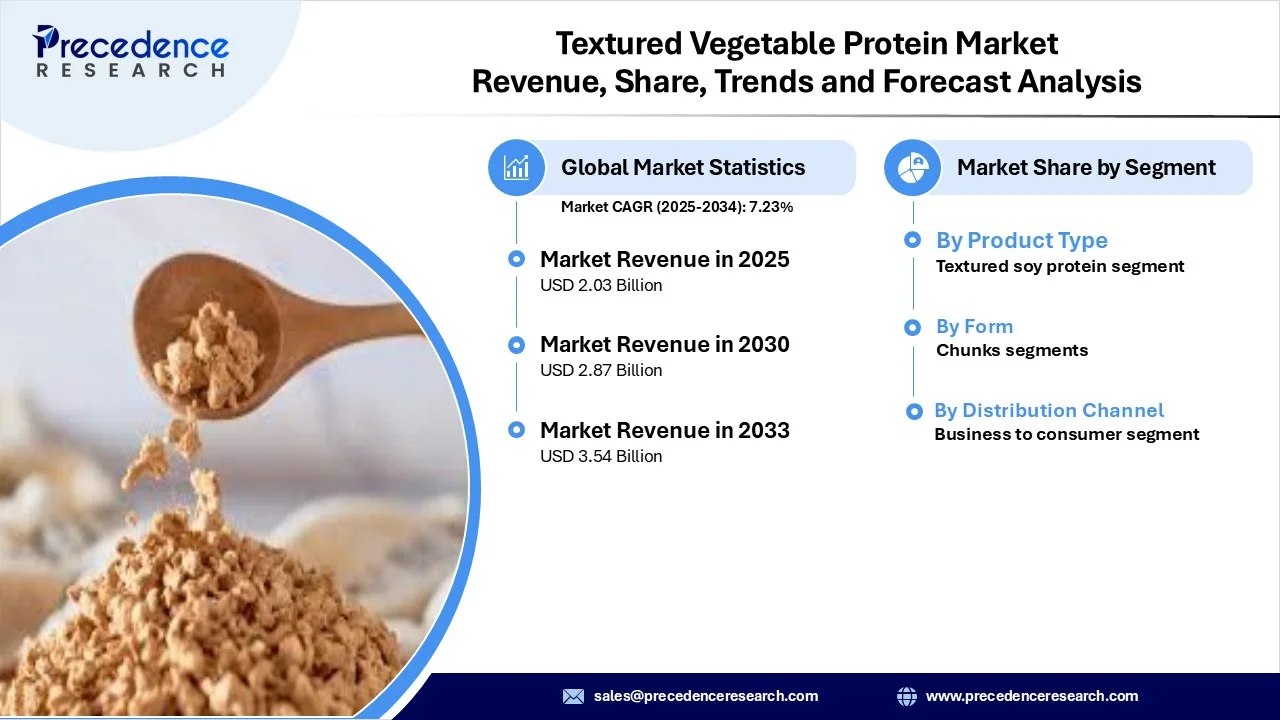Textured Vegetable Protein Market Revenue to Attain USD 3.54 Bn by 2033
Textured Vegetable Protein Market Revenue and Trends 2025 to 2033
The global textured vegetable protein market revenue reached USD 2.03 billion in 2025 and is predicted to attain around USD 3.54 billion by 2033 with a CAGR of 7.23%. The growth of the textured vegetable protein market is driven by increasing consumer preference, rising awareness about health benefits, expanding vegan population.

Expanding the Horizons of Textured Vegetable Protein
The textured vegetable protein market is expanding rapidly and is expected to continue to grow as consumers increasingly look to plant-based diets and sustainable options for food choices. Increased health awareness, the growing number of vegan consumers, and concerns regarding the environmental effects of animal farming are driving food consumption made from plant-based proteins.
Textured vegetable protein, which consists primarily of soy, wheat, or pea, is a nutritious substitute for use in place of meat in foods. Textured vegetable protein is commonly used in meat analog products, prepared meals, and as a food processing ingredient in various types of baked goods. The total market will grow swiftly, as food manufacturers make investments in formulations and products that appeal to consumer preferences around the world.
Segmental Analysis
- By Product Type- Textured soy protein has a strong hold on the market with its high content of protein, low cost, and flexibility in using its applications in the plant-based foods market (e.g. meat alternatives, snacks, and ready meals).
- By Form- Chunks dominate because they provide a meat-like texture, making it appealing to both flexitarians and vegans. This has aided their adoption in commonly consumed products around the world, including curries, stews, and burgers.
- By End User - The consumer segment dominates the market. Demand for plant-based diets has increased everything from the availability of vegan products at retail, to consumers seeking more sustainable protein-rich options in the foods they consume.
Regional Analysis
Asia Pacific leads the market for textured vegetable protein due to large, established production of soy and pulses, culturally entrenched plant-based eating habits, and rapidly increasing food processing capacity. Strong consumer recognition of meat alternatives, access to price-competitive raw materials, and growing foodservice and packaged food channels sustain a consistent pull on demand. Manufacturers in the region emphasize scale, locally formulated products and partnerships with ingredient suppliers to meet domestic and export demand while promoting innovations in texture and flavor of meat analogs.
North America is the fastest growing region in textured vegetable protein market as a result of strong consumer shifts to plant-based eating, substantial product innovation, and strong retail and food service ecosystems. The demand is driven by health, sustainability and animal welfare concerns, which drive launches of non-GMO, cleaner label, and high-protein formulations. Ingredient suppliers and manufacturers are investing in R&D, branding, and co-development with food producers to enhance sensory quality and broaden user acceptance of meat analogs.
Textured Vegetable Protein Market Coverage
| Report Attribute | Key Statistics |
| Market Revenue in 2025 | USD 2.03 Billion |
| Market Revenue by 2033 | USD 3.54 Billion |
| CAGR from 2025 to 2033 | 7.23% |
| Quantitative Units | Revenue in USD million/billion, Volume in units |
| Largest Market | Asia Pacific |
| Base Year | 2024 |
| Regions Covered | North America, Europe, Asia-Pacific, Latin America, and the Middle East & Africa |
Key Players in RNA Interference Drug Delivery Market
- Archer Daniels Midland Company (ADM)
- Cargill, Incorporated
- Roquette Frères
- Ingredion Incorporated
- Vippy Industries Ltd
- Axiom Foods, Inc.
- Sonic Biochem Extraction Pvt Ltd
- Bunge Limited
- MGP Ingredients, Inc.
- Bob’s Red Mill Natural Foods
- Wilmar International Limited
- Sojaprotein
- Gushen Biological Technology Group Co., Ltd.
Recent Developments
- In June 2025, ACI Group has entered into a long-term distribution agreement with International Flavors & Fragrances (IFF) for its range of plant-based proteins in the UK and Ireland, providing customers a diverse selection of ingredients suited for plant-based food manufacturing. (Source: http://vegconomist.com)
Get this report to explore global market size, share, CAGR, and trends, featuring detailed segmental analysis and an insightful competitive landscape overview @ https://www.precedenceresearch.com/sample/6986
You can place an order or ask any questions, please feel free to contact us at sales@precedenceresearch.com |+1 804 441 9344